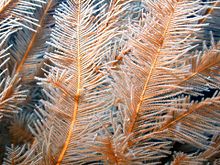| Plumapathes pennacea | |
|---|---|

| |
| Scientific classification | |
| Domain: | Eukaryota |
| Kingdom: | Animalia |
| Phylum: | Cnidaria |
| Class: | Hexacorallia |
| Order: | Antipatharia |
| Family: | Myriopathidae |
| Genus: | Plumapathes |
| Species: | P. pennacea |
| Binomial name | |
| Plumapathes pennacea (Pallas, 1766) | |
| Synonyms | |
| |
Plumapathes pennacea is a species of black coral in the order Antipatharia. It is found in the tropical Indian, Pacific and Atlantic Oceans in deep reef habitats where it forms part of a biologically diverse community.
Description
Black corals are so called because the main axial skeleton is made of a spiny, keratin-like substance called "antipathin" which is a dark brownish-black. This colonial coral has a bushy, two dimensional form and grows out of a holdfast firmly anchored to a rock. It can grow to 1.5 m (5 ft) tall and a similar width. The slender branches fork at intervals and divide pinnately, and the smallest pinnules are a few centimetres long and close together, forming a feather-like effect. The polyps are golden brown, brown or blackish, the ones on the pinnules being paler in colour; they may make the axis appear dark red. The size and shape of the polyps vary across the colony, with the polyps most distant from the holdfast being more elongate than the others. Each polyp has six, non-retractile, unbranched tentacles.
Distribution and habitat
Plumapathes pennacea is found in tropical parts of the Indian, Pacific and Atlantic Oceans; it occurs as deep as 330 m (1,100 ft) but is most common between 25 and 60 m (80 and 200 ft), and even shallower than this in caves and under dark overhangs. It is present in the Caribbean Sea, the Bahamas and southern Florida, but not in Bermuda.
Ecology
A number of other organisms live on this coral or are associated with it. Algae, hydroids and bryozoans settle and grow on the branches, and several species of shrimps, stalked barnacles, molluscs and fish are associated with it, many as symbionts with some hiding among the branches, and others feeding on the polyps. The living tissue of the coral may grow over the surface of the black coral barnacle (Oxynaspis gracilis). Growth rates of black corals are low and this coral lives for thirty or more years.
References
- Pallas, P.S. (1766). Elenchus zoophytorum. The Haague: Van Cleef. p. 209.
- Jacob van der Land (2013). "Plumapathes pennacea (Pallas, 1766)". WoRMS. World Register of Marine Species. Retrieved 20 June 2017.
- ^ Colin, Patrick L. (1978). Marine Invertebrates and Plants of the Living Reef. T.F.H. Publications. pp. 294–299. ISBN 978-0-86622-875-6.
- ^ "Feather black coral (Plumapathes pennacea)". Interactive Guide to Caribbean Diving. Marine Species Identification Portal. Retrieved 21 June 2017.
- Lesser, Michael (2013). Advances in Marine Biology. Academic Press. p. 112. ISBN 978-0-12-394282-1.
- Wicksten, Mary K.; Nuttall, Marissa F.; Hickerson, Emma L. (2014). "Crustaceans from antipatharians on banks of the northwestern Gulf of Mexico". ZooKeys (457): 45–54. Bibcode:2014ZooK..457...45W. doi:10.3897/zookeys.457.6280. PMC 4283364. PMID 25561830.
- Lesser, Michael (2013). Advances in Marine Biology. Academic Press. p. 90. ISBN 978-0-12-394282-1.
| Taxon identifiers | |
|---|---|
| Plumapathes pennacea | |